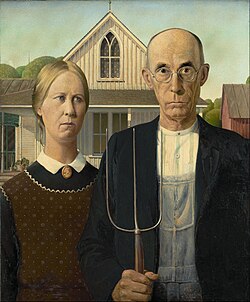- American Gothic (1930), by Grant Wood
- Ella Watson, with an adopted daughter and three of her grandchildren
- Uncropped version of the photo
| American Gothic | |
|---|---|
 Alt text: Black and white photo of a somber middle-aged black janitress wearing rimless glasses and a polka dot dress stares off to the side. She holds a corn broom head up and wet mop head up in front of her. A large American Flag hangs vertically in the background, slightly out of focus. | |
| Artist | Gordon Parks |
| Year | 1942 [1] |
| Medium | Gelatin silver print [2] |
| Subject | Ella Watson [1] |
| Dimensions | 61 cm× 51 cm(24 in× 20 in) [2] |
American Gothic (also known as American Gothic, Washington, D.C. [2] ) is a photograph of Ella Watson, an American charwoman, taken by the photographer Gordon Parks in 1942. [3] [4] [5] [6] [7] [8] [9] [10] [11] [ excessive citations ] It is a reimagining of the 1930 painting American Gothic by Grant Wood. [7]
Contents
Time magazine considers American Gothic one of the "100 most influential photographs ever taken". [1] [12]


